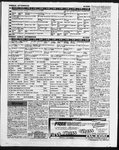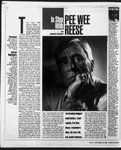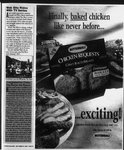| OCR Text |
Show How the Food Bank Farm can afford to Seed the hungry NESTLED ON 60 acres ofland in Hadley, Mass., is a farm that is unlike most others. Besides providingits “shareholders” with fresh, organically grown vegetables and fruits—everything from peas to rutabaga to watermelon—at or below supermarketprices, the farm annually gives ANDstill be a good dealfor its customers. awayhalfofits harvest, about 100,000 pounds, to emergency food pantries, shelters and programs for the elderly. Michael Docter, 34,is the directorofthe Food Bank Farm, which thrives without any help ze ; it,” says Docter. “Our share& holders get a good deal, and wecan use the money to give away food to people whoneed it.” Three times a week, Jim Levey—the food procurementdirector for the Northampton Survival Center, an emergency food pantry— drives to the farm to collect free vegetables, which he then takes back to the center. The needy come to the center and take their pick. How did the farm get Started?“We wanted to take an entrepreneurial approach to getting produce into the stream ofgoods distributed to food pantries,” said Dafrom the “All vid Sharken, the execuwe wantis for people to tive director of the Food use their food dollars Bank of Western Massahere,” said Docter, “and chusetts. “To do that, we not in the supermarket.” knew we needed control How can such a farm over our ownland.” work? How can it afford After searching for a to help feed the hungry and year, Michael Docter still be a good deal for found his 60 acres. With 3? The farm, setup the helpofa state law deby the Food Bank ofWestsigned to protectrural arem Massachusetts—a eas from urban developfood distribution netment, the Food Bank took work—stays in business out a mortgage from the byselling “shares”to resVermontNational Bank’s idents. Shareholders are Socially Responsible Bankfound by word-of-mouth ing Fund and bought the or by brochures distribland for well below market uted throughoutthe area. value. Then, Ralph Taylor, The shares cost between $350 to $450 each and Michael Docter (in hat), who runs the Food Bank Farm, with shareholders, Ed and Deborah Chrzanowski and their atgphilanthropist, stepped in the farm’s cane d for a 20N8, dosh 14, (with glasses) and Justin, 10. “We make our share last all year by freezing and canning,” Toanaiie had met DSceee fixed amount ofproduce each year. One share is good through friend several years ago. “I was ready to infor up to 30 pounds of vegetables every week from vest whatever was necessary,” he said. Mayto November and, at the peak ofthe growing seaIn 1992, Docter moved onto the property with his son, shareholders can choose from more than 30 difwife and son, and as word spread aboutthe project, ferent kinds of vegetables. students and residents from the area got involved. Today, more than 400 shareholders support the Several farmers taught Docter how to repair mafarm, whichis called a Community-Supported Agrchinery, howto cultivate land and howtoraise crops. iculture project. “We serve nearly 600 families and Docter and Linda Hildebrand, the harvest manthe share size is so large that two or three households ager, are the farm’s only full-time employees. Voloften buy together,” said Docter. unteers, mostly students from nearby colleges and Though there are more than 500 such farms throughworkas needed. out North America, the Food Bank Farm is the first and one how wonderful they are. We make ourshare last Last year, the farm threw a party to celebrate paying only one committed to giving awayhalfofits harvest. all year by freezing and canning.” off its mortgage seven years ahead ofschedule.All ofthe When visited, shareholders were picking up vegetaThe farm's family atmosphere offers added appeal. shareholders were invited. Carol Rothery, the adminisbles for the week. Inside the main barn, families toting Children pick as much asthey wish oftomatoes, peas— trative director ofthe Northampton Survival Center, told Paper bags gathered around wooden tables laden with and even flowers. And they can helpoutin other ways me about one woman who started giving staff members sulk ht besosetigntana a beets. They dug into har- too. Today, the Chrzanowski family helped prepare the ae for a soup she couldn’t afford to make for vest buckets and boxes filled with squash and pumpkins. food for distribution.Ed saysit’s a good experience for ears. “It’s a huge psychological boost for people to be Ed Chrzanowskiand his wifes Deborah,of near- his sons, Josh, 14, and Justin, 10. “Whentheyhelpout, abetto choose food for themselves,” said Rothery. [f by Chicopee, Mass., have been shareholders for four rete) know the importance ofwhat we're doing,” years. Coming to thefarm, says Deborah, has changed he told t’s aboutbeing thankfulfor what we have.” For advice on howtostart a community-supported the way her family eats. “I never ate collardsbefore,” Families, though,pitch in only if they wantto. farm,write: The Food Bank Farm of Western MassaDeborah said, laughing. “Now I can’t stop telling every- “This is a consumerdeal and that’s the way welike chusetts, 115 BayRoad, Dept. P, Hadley, Mass., 01035. “Ourshareholders get a good deal, andwe can use the money to give awayfoodtopeople who need it,” says MichaelDocter, the directorofthe FoodBank Farm. BY PARADE MAGAZINE - SEPTEMBER 15, 1996 - PAGE 25 ALR Re BT Wak BST E R |
































































































































































































































